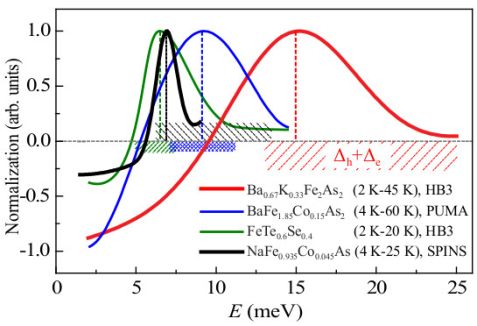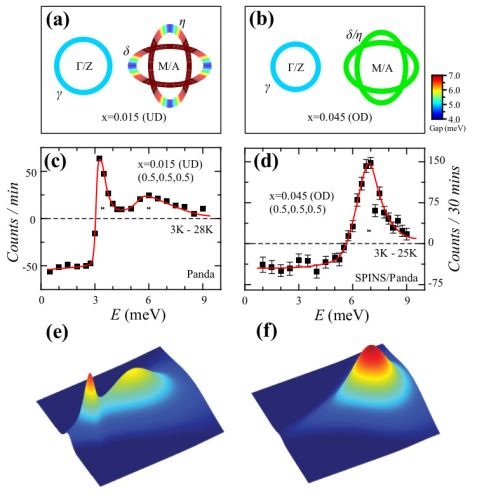MLZ ist eine Kooperation aus:
 > Technische Universität München
> Technische Universität München > Helmholtz-Zentrum Hereon
> Helmholtz-Zentrum Hereon
 > Forschungszentrum Jülich
> Forschungszentrum Jülich
MLZ ist Mitglied in:
 > LENS
> LENS > ERF-AISBL
> ERF-AISBL
MLZ in den sozialen Medien:

MLZ
Lichtenbergstr.1
85748 Garching
Neutron spin resonances in superconducting NaFe1-xCoxAs
C. Zhang1,2, H. F Li3, Y. Su3, T. Das4, R. Yu1, G. Tan2, Y. Song1,2, A. Schneidewind3, E. Faulhaber5, O. Sobolev6, J. A. Fernandez-Baca2,7, Th. Brückel3, A. V. Balatsky4, Q. Si1, T. Egami2,7, and P. Dai1,2
1Department of Physics and Astronomy, Rice University, Houston, USA
2Department of Physics and Astronomy, University of Tennessee, Knoxville, USA
3Jülich Centre for Neutron Science (JCNS) at MLZ, Forschungszentrum Jülich GmbH, Garching, Germany
4Theoretical Division, Los Alamos National Laboratory, Los Alamos, USA
5Heinz Maier-Leibnitz Zentrum (MLZ), Technische Universität München, Garching, Germany
6Institut fur Physikalische Chemie, Georg-August-Universitat Göttingen, Göttingen, Germany
7Oak Ridge National Laboratory, Oak Ridge, Tennessee, USA
The presence of spin resonance in neutron spectroscopy is a hallmark of unconventional superconductivity. It is generally believed that the neutron spin resonance is directly related to the superconducting gap and electron pairing symmetry. We have investigated the spin resonance phenomenon in NaFe1-xCoxAs superconductors comprehensively at the high-flux tripleaxis spectrometers PANDA and PUMA. In the slightly overdoped regime, we observed a very sharp spin resonance, which cannot be reproduced within an S++-wave pairing symmetry, therefore giving compelling evidence on the S+--wave scenario. On the contrary, double spin resonances were observed unexpectedly in the underdoped region. We strongly argued that they are likely to be related to an anisotropic superconducting gap, thus highlighting the important role of orbitals in understanding the pairing mechanism of the multi-orbital electrons in iron based superconductors.
Sharp spin resonance
In iron based superconductors, theories based on the S+--wave pairing symmetry predict the presence of a sharp neutron spin resonance at an energy below the sum of the hole and electron superconducting (SC) gap energies (i.e. E ≤ 2Δ) below TC. On the other hand, a broad spin excitation enhancement is expected from the S++-wave pairing symmetry at an energy above 2Δ below TC. While the resonance has been observed in a number of iron based superconductors at an energy below 2Δ consistent with the S+--wave pairing symmetry, the mode has also be interpreted as arising from the S++-wave pairing symmetry with E ≥ 2Δ due to its broad energy width (see fig. 1) and the large uncertainty in determining the SC gap. Via comprehensive inelastic neutron scattering experiments carried out at PUMA and PANDA, we observed a sharp spin resonance at the wavevector (0.5,0.5,0.5) at E = 7 meV in the slightly overdoped NaFe0.935Co0.045As superconductor (TC = 18 K) [1] (see fig. 2(d)), which is several times sharper than resonances usually observed in other iron based superconductors. By comparing to the calculated spin excitation spectra within both S+-- and S++-wave pairing symmetries, we conclude that such sharp resonance can only be reproduced in the former scenario, thus giving compelling evidence on the S+--wave pairing symmetry for iron based superconductors.
Double spin resonances
In contrast to the single resonance for the overdoped NaFe0.935Co0.045As, surprisingly, we observed double spin resonances at the same commensurate wavevector for the underdoped NaFe0.985Co0.015As superconductor (TC = 15 K) [2] (see fig. 2©). The resonances in NaFe0.985Co0.015As peak at 3.25 meV and 6 meV, respectively, and both track down TC. This is fundamentally different from the c-axis dispersion of the resonances in the electron-doped BaFe2As2 and hole-doped copper oxide superconductor YBa2Cu3O6.85. The doping evolution of the spin resonance coincides with that of the SC gap anisotropy in ARPES experiments. Our experimental discoveries, together with our theoretical analysis, thus strongly suggests that the orbital selectivity plays an important role in understanding the SC pairing of the multi-orbital electrons in the iron pnictides.
In iron pnictides, the Fermi surface is composed of multiple orbitals. In electron doped
NaFe1-xCoxAs, the dominant orbital character of the electron pockets would be either dxy or dxz/yz, depending on the direction in the Brillouin zone (see fig. 2(a) and 2(b)). Recent theories and experiments find that the effective strength of electron correlations can be very different between the dxy and dxz/yz orbitals. This may induce orbital selective SC pairing strengths, which naturally give anisotropic SC gaps along the electron pockets. The neutron resonance in the SC state is a bound state at energies just below the particle-hole excitation energy Er ≤ Δh + Δe. The anisotropic SC gap in the electron pocket is large. As in the underdoped NaFe0.985Co0.015As, there are two characteristic gaps Δe1 ≠ Δe2 (respectively associated with dxy and dxz/yz orbitals). Two resonance peaks are expected as a result of this separation of energy scales (see fig. 2(e)). As the electron doping is increased to the overdoped regime, the orbital selectivity of the correlations is reduced, giving rise to a smaller SC gap anisotropy with Δe1 ≈ Δe2. Therefore, only one resonance peak will present (see fig. 2(f)).
Because the multiplicity of electron orbitals is a distinct feature of the iron-based superconductors and is likely to make a major contribution to their superconducting pairing, our results further suggest that resonance, superconducting gap and TC in underdoped region of NaFe1-xCoxAs cannot be simply scaled by a universal relationship.
Experiments at PANDA and PUMA
All essential inelastic neutron scattering results were obtained at the high-flux triple-axis spectrometers PANDA and PUMA at MLZ. Measurements were mainly carried out by using a focusing PG monochromator and analyzer with a fixed final neutron energy of Ef = 14.7 and 5 meV, respectively. About 5 g of single crystals of overdoped NaFe0.935Co0.045As and underdoped NaFe0.985Co0.015As were prepared by the self-flux method.
References:
[1] C. Zhang et al., Phys. Rev. B 88, 064504 (2013).
[2] C. Zhang et al., Phys. Rev. Lett. 111, 207002 (2013).
MLZ ist eine Kooperation aus:
 > Technische Universität München
> Technische Universität München > Helmholtz-Zentrum Hereon
> Helmholtz-Zentrum Hereon
 > Forschungszentrum Jülich
> Forschungszentrum Jülich
MLZ ist Mitglied in:
 > LENS
> LENS > ERF-AISBL
> ERF-AISBL
MLZ in den sozialen Medien:




